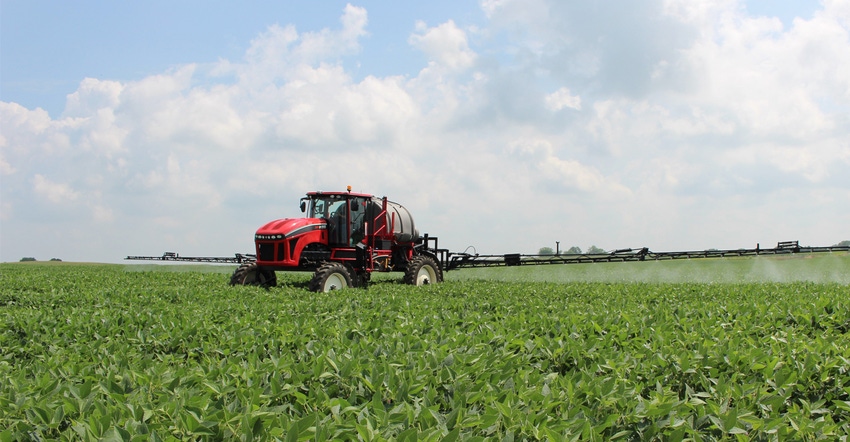December 15, 2020

The more things change, the more they stay the same. It’s an old saying, and one a farmer used in a conversation we had recently about his sprayer situation. What he was getting at was that every few years he has to do something to increase sprayer capacity, either hiring some custom application or upgrading his own application equipment.
Then for a few years, things go well until the cycle repeats, where pests, acreage or some other dynamic changes. He must find a way to cover more acres in similar or even smaller spray windows, so he adds capacity again.
Many farmers and custom applicators face the same continual cycle; some say they feel like the cycle is speeding up. That’s probably part of the reason today’s $2.2 billion ag sprayer market is forecast to hit $3.1 billion by 2025.
Why the increased interest?
Several factors are behind the increased interest in sprayers, but I hear some of the same reasons often. Getting acres covered in the tight herbicide and weed size windows that often overlap with planting time is challenge No. 1.
Another issue that comes up is an increasing number of pests to deal with that may require more acres to be covered. Spider mites, Japanese beetles and soybean gall midge are recent examples farmers cite as having to deal with or at least have a plan to deal with at some point in the near future. With some of our primary weed control systems having significant label changes, farmers (and retailers) talk about facing further challenges with getting over their acres on time and within label.
Growers and ag retailers say the new labels mean fewer hours available that are fit to spray, so they are looking for more sprayer capacity to try to keep up. And while these regulations do shrink the time we have for spraying some herbicide products on soybeans especially, applicators don’t see the new label as the only reason to increase capacity.
With weeds — herbicide resistant or not — needing to be treated in such tight windows (4 inches is the upper end of many herbicide labels), we have to be timelier than ever regardless of what program we are using.
Large, medium or small?
There are all sorts of formulas and opinions on how wide a boom and how big a tank you need to fit your operation. Using those as a rough guide, consider buying as much quality and capacity as your budget allows. What sprayer options should you buy? Look at your farming or custom spraying operation and see what adds the most value for you. Here are some factors to consider:
Cleanup. Stainless steel tanks and plumbing are typically easier to clean; direct chemical injection systems also help with this.
Automation. Automatic boom section controls (or even more precise individual nozzle controls) can save time, reduce operator fatigue, save on excess chemical costs, and reduce risk of crop injury or skips. Depending on field shapes, sizes and obstacles, this can all add up.
Horsepower. No sprayer operator has ever said, “That’s too much horsepower.”
Lighting system. You can get by without high-end lights, but if you have them, you’ll appreciate them.
Boom height. Boom height and leveling systems are almost a “must have” item now, given the increasing number of herbicides mandating specific maximum boom heights above the crop (for example, dicamba is 24 inches).
Added value. Another factor farmers bring up is “What else can I do?” Some newer rigs can be fitted with dry fertilizer boxes so growers can consider spreading their own P and K. They can also fit the bill for a growing trend — broadcasting dry N in corn at sidedress time.
Comfort level. A question to consider that I learned the hard way: Is the sprayer comfortable to operate? Somebody, probably you, will be spending lots of time with your sprayer. How’s visibility? Would you rather have a front- or rear-mount boom? Consider autosteer, quality guidance and autoswath to reduce fatigue as well.
New or used?
My best, quick answer: It depends. I don’t know which is better for you. It’s hard to predict frequency, duration and cost of downtime for a used sprayer. There are some good ones that will be nearly as reliable as new. There are also some that will keep service technicians and welding shops rolling in dough. Some of the reliability (or lack thereof) can be inherent in certain makes and models. Experience with a lot of used rigs leads me to think that how well previous owners cared for the machines is the primary factor in keeping them in the field and out of the shop.
New rigs may have occasional issues, but they get the nod for initial reliability. Does that offset the increased cost of “new”? It depends on what the new vs. used price difference is; frequency and cost of repairs; availability of a backup plan; timing of the breakdowns; and many other factors specific to each operation.
If you can find them, “lightly used” rigs can sometimes offer a lot of sprayer capacity for the money versus brand new. Another perspective is we can see how various sprayers’ drivetrains and spray system components have worked out in rigs with some hours on them. With technology that’s been on the market a year or two, we have a better idea if it worked well, if there were some issues and they’ve worked the bugs out, or if something was particularly troublesome and needs to flat out be avoided.
On the other hand, we may be missing out on some great new sprayer technology by going with a used rig. See how this argument goes round and round? Another complicating factor is as the used sprayer market has heated up, the price gap between late model used versus new in comparable rigs has narrowed.
Homework can pay off
Ask other farmers and custom applicators for their recommendations. Do a little research on brands you may be interested in and look for their track record, ease of repair and availability of parts.
In my former life as a co-op manager, I learned a hard lesson when we had a fairly new rig with a blown wheel motor. It turned out that each wheel took a different model of motor, and being expensive, inventory was low and scattered around the Midwest. Hopefully, some background work will save you sitting for days during peak season waiting on hard-to-find replacement parts, or an overnight trip to a parts warehouse.
There is a wide range of “tender loving care” given (or not given) to sprayers depending on the operators and terrain in their history. A high-hour machine that spent its life cruising around in the long, smooth rows of one region may be a better value than a low-hour rig from an area with lots of short rows, starting and stopping, sharp turns, and slopes with potential bouncing through ditches, ruts and other obstacles. Then again depending on the operator and maintenance, the exact opposite could be true.
When you are shopping don’t hesitate to inspect and test anything remotely in your price range — good, bad and everything in between. That’s how you’ll get a good eye for what kind of life the sprayer had (and has left).
McGrath is the Extension coordinator for the Iowa Soybean Research Center at ISU. Email [email protected].
About the Author(s)
You May Also Like






